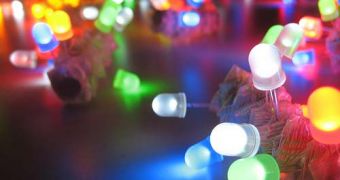LED, or light emitting diodes, are recognized for their properties of providing low power, color rich, long lived lighting sources, however they might already be out of date, as recently a new type of LED has been designed, by using the quantum-dot technology. It seems that the new quantum-dot LED, or QDLED, is far better than its cousin, thus providing increased clarity and richer colors, and cheaper means to construct them.
A quantum dot represents a nanoscale semiconductor structure, which is used to confine electrons in three dimensions, thus it can be constructed from a cadmium selenide core which incorporates a zinc sulphide shell, in which electrons are excited to high energies, as they travel towards the 'holes' between the core and the shell, exciting the quantum dot that converts the energy received from the electron into light.
Multiple colors can be obtained, by changing the size of the quantum dot, that emits light in a different spectrum. The new device, as the currently used LED's operate with a voltage of about 3 to 4 volts, however the QDLED can run for over 300 hours using power from the same battery without loosing brightness.
Nevertheless, currently produced LEDs are far more efficient that the QDLED design, since it can provide enhanced luminosity. This does not present problems for the QDLED, since it might eventually be used for making displays that run on low power, and it also has the advantage that it can be used to generate several colors, while LEDs must be mixed to reproduce a specific color.
According to Andrew Wang of Ocean NanoTech in Fayetteville, most Liquid Crystal Diode monitors produced today have a brightness of about 500 candelas per square meter, while the QDLED's produced can reach about 9000 candelas per square meter, meaning they are the most brightest quantum-dot LED's ever produced.
The technology to produce such devices involves a solution-processing technique, similar to that used by ink-jet printers, which is much more simpler than the classic LED production process that require vapour depositing techniques, thus the QDLED would probably be available for marketing very soon.
The prototype created at Massachusetts Institute of Technology in 2002 was able to produce 7000 candelas per square meter, and used a single layer of quantum dots, while the new device uses multiple layers in order to enhance the brightness.

 14 DAY TRIAL //
14 DAY TRIAL //